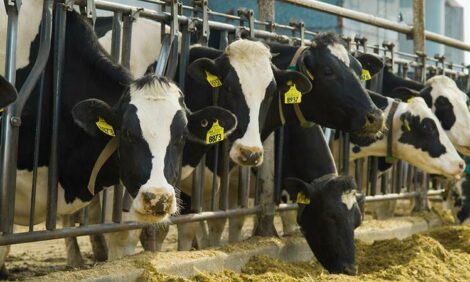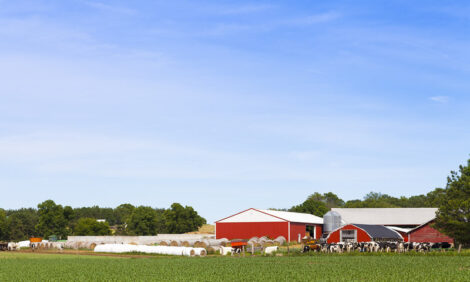



Questions and Answers on Hormones in Meat and Milk
Germany's Federal Institute for Risk Assessment (BfR) answers some frequently asked questions on the possibility of human health risks from hormones in meat and milk.The BfR is often asked about the possible health risks of hormones in meat and milk. This involves questions about hormones which occur naturally in meat as well as questions about hormone preparations used with livestock. There is also discussion about the possible health risks after consuming meat originating from animals from non-European Union countries in which different legal regulations apply.
Against this background, the BfR has summarised the most important questions and answers on the subject.
What are hormones?
Hormones are chemical messenger substances which convey specific signals for the regulation of endogenous processes within the body (Greek hormon = impetus). To guarantee that only cells of the target tissue react specifically to the signal, these cells are equipped with the corresponding receptors which specifically bind the hormone. Cells without this receptor cannot bind any hormones and 'ignore' the signal.
Can hormones be contained naturally in meat?
As hormones are chemical messenger substances formed by the body for the regulation of endogenous processes, meat such as muscle meat, liver and kidneys contains natural hormones.
Under what circumstances can the natural hormone level fluctuate in meat?
Higher hormone levels can occur in uncastrated as opposed to castrated animals. With uncastrated boars, for example, nandrolone has been detected in some high concentrations as a natural metabolite of the testosterone metabolism in the liver, kidneys and testicles. In the muscle meat, on the other hand, the nandrolene levels are roughly the same in castrated and uncastrated animals.
If marketed at all, the meat of pregnant animals contains naturally higher levels of certain hormones than the meat of animals that are not pregnant. Another source of hormonally effective substances which can occur in muscle meat or edible organs is to be found in mycotoxins with an oestrogenic effect (e.g. zearalenone) which are formed by certain fungi and can infest cereal crops such as maize, wheat and barley. The meat of livestock which has ingested feed contaminated with zearalenone can then possibly contain additional low levels of these hormonally effective substances. Meat is understood to be all of the edible parts of the animal carcass, such as muscle meat or liver.
Which foods are the main sources of hormones?
Levels of progesterone, testosterone and oestrogen are higher in milk than they are in muscle meat or the edible organs of slaughtered animals or in fish, eggs and vegetable foods. A considerable proportion of the daily adult total intake of oestrogens (approximately 60 per cent) and progesterones (approximately 80 per cent) via these foods comes from cow’s milk.
Do naturally occurring hormones have a different effect than synthetically produced
hormones?
Naturally occurring and synthetically produced hormones do not normally differ with regard to their effect mechanism at the receptor. Under certain circumstances, however, synthetically produced hormones can have a different potency or can differ from hormones produced in the body in the intake, distribution or metabolism. This means that some synthetic hormones take longer to metabolise in the body, which means that their retention time within the body can be longer. The metabolic products of synthetic hormones can also have a different potency from the basic substance, or they can interact with other receptors to unfold a different activity spectrum.
Is the use of hormones in animal feed allowed?
The use of hormones in animal feed is not generally permitted within the European Union (EU).
In the past, substances with a hormonal effect were used for fattening purposes (so-called 'feeding hormones') because they improve the animals’ feed conversion ratio, a term used to describe how many kilograms of feed an animal has to ingest to gain one kilogram of body mass. Due to the possible health risks for humans and the change in ethical and environmental consciousness, the use of feeding hormones of this kind in livestock production was banned throughout the EU in 1988.
Is the use of hormones with livestock fundamentally prohibited?
Hormones may be used in livestock farming for breeding and therapeutic purposes. The hormones authorised for use in livestock farming are listed in Table 1 of the appendix to Regulation (EU) No. 37/2010. They may only be used in accordance with specific regulations.
After treatment, the waiting times specified in the authorisation procedure must be complied with until the animal is slaughtered or its products are allowed to be traded again. With livestock, the possible areas of application for hormones include cycle synchronisation, the treatment of fertility disorders and the termination of undesired pregnancies.
Are hormones being detected in food?
In Germany, control of the use of pharmacologically effective substances in animals and evidence of their use in foods of animal origin are the responsibility of the regional authorities in each federal state. Accordingly, regular checks are made for residues of banned or unauthorised hormones by the monitoring authorities within the scope of the National Residue Control Plan.
An overview of the results of the tests of food of animal origin by the national monitoring authorities in Germany is provided every year by the Federal Office of Consumer Protection and Food Safety (BVL). In the years 2008-2012, there was only one positive finding in horse urine, even though the hormone detected in that instance can also occur naturally.
The European Food Safety Authority (EFSA) reports on the monitoring for residues of medicinal products and other substances in animals and foods of animal origin. In 2010, 0.19 per cent (90 of 47,337 samples) tested positively for hormones. In 2011, 0.11 per cent (53 of 46,378 samples) tested positive in the same class.
Are there any health risks connected with the consumption of meat due to the administering of hormones to livestock as veterinary drugs?
A health assessment of the substances is made within the scope of the authorisation process of veterinary drugs during which an 'acceptable daily intake' (ADI value) is determined. The ADI stipulates the quantity of a substance which can be ingested every day over an entire life span without endangering consumer health. On the basis of the ADI value, so-called maximum residue quantities which may not be exceeded are determined for certain foods.
If the waiting times laid down in the authorisation process between the administering of hormones and the slaughter of the animals are complied with, it has to be assumed that the determined maximum residue levels of the hormones used in foods of animal origin will not be exceeded, so that a risk to consumer health can be practically excluded. This also applies to veterinary drugs intended for cycle synchronisation.
Are there any health risks for consumers posed by the consumption of meat acquired from animals treated with hormones to enhance their performance?
In the European Union, there is a general ban on the use of hormones to enhance animal performance and/or promote growth in livestock production, but there is no ban of this kind in all third-countries.
At the request of the European Commission, the European Food Safety Authority (EFSA) published a report in 2007 on examinations of the effects of hormones used legally in third-countries for the production of animal foods in those countries. It focused, among other things, on hormones used to promote animal growth in third-countries. In this report, EFSA comes to the conclusion that not enough toxicological data are available to make a final assessment of the health risks which could result from the consumption of the meat.
Are any health risks involved in the consumption of meat with increased natural hormone levels?
Natural hormone levels in meat can fluctuate. Within the scope of the National Residue Control Plan, regular samples for steroids are examined with a difference being made between synthetic and natural steroids. In the years 2008 to 2012, neither oestradiol nor testosterone were detected in the analysed samples.
On the basis of the data on steroid hormone levels in the musculature of pregnant animals available in the literature, it has to be assumed that the actual intake quantities of oestradiol and progesterone lie well below the acceptable daily intake quantity.
Which hormones can occur in milk?
Cow’s milk is a food acquired from animals which naturally contains hormones. These include naturally occurring female sex hormones, such as progesterone, which belongs to the corpus luteum hormones, and oestrogens, which are also known as follicle hormones.
How high are the levels of hormones in milk?
Overall, the quantities of progesterone and oestrogens ingested during the intake of normal quantities of cow’s milk are relatively low compared with the quantities of these hormones which are produced in the human body anyway. This applies in particular to adult women with a naturally high self-production of these hormones. The level of progesterone in full-fat milk (fat content 3.5 per cent) is roughly 10 micrograms per kilogram of milk. As progesterone is fat-soluble, lower progesterone concentrations are to be found in low-fat milk and higher concentrations in products richer in fat, such as butter.
The natural oestrogens include oestrone and in particular oestradiol as important representatives of this group. In full-fat milk (fat content 3.5 per cent), total concentrations are given as 0.13 micrograms of oestrone and less than 0.02 micrograms of oestradiol per kilogram of milk.
Why do hormone levels in milk fluctuate?
The level of natural sexual hormone production in dairy cows depends on the point in time in the cycle and/or lactation. Accordingly, the levels of progesterone and oestrogens vary in individual samples of cow’s milk. The observation of the hormone levels of ready-to-drink milk relates to bulk milk, which is a mixture of different milk batches with different hormone concentrations. One of the results of this is that the details of the hormone concentrations measured in milk vary widely in the scientific literature.
Are any health risks due to hormone levels connected with the consumption of milk?
With consumption of normal quantities of milk under consideration of an orientation value for the daily intake of milk (including yoghurt) of 200 to 250g, the hormone quantities that can be expected to be ingested should be seen as very low compared to the natural self-synthesis of these hormones in humans. Furthermore, the hormones are metabolised very quickly (pronounced “first pass” effect of the liver with peroral intake). The available scientific data do not currently give any reason to assume any relevant health risk.
July 2014


